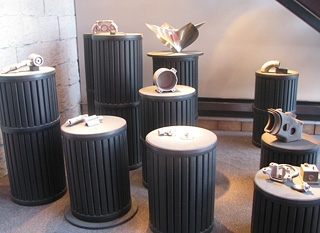Wisconsin Precision Casting Corp.
W405 County Road L, East Troy
Industry: Investment casting
Employees: 85
www.wisconsinprecision.com
East Troy-based Wisconsin Precision Casting Corp. is celebrating its 50th year in 2014. The company now employs 85 people, has reached $13 million per year in annual sales and is looking to grow.
Cliff Fischer, co-owner and vice president of operations, said the company has “outgrown its own footprint” after a half-century in business.
“We’re busting at the seams right now,” he said. “Our growth has exceeded our internal capacity so we’re looking at some opportunities for growth. Hopefully, in our 50th anniversary year, we’re either going to be building across the street – we own the 12 acres of land across the street – grow through acquisition, or through some minor internal additions to buy us a few years of growth.”

The company, located at W405 County Road L in East Troy, has a 40,000-square-foot facility, with three balanced shifts running 24 hours a day, six days per week because the company is so busy, Fischer said.
Wisconsin Precision serves a wide range of customers, from big companies like John Deere and Caterpillar to small, “mom and pop” manufacturers.

“We are an investment casting company and our vision is to do the more highly engineered, more complicated, low-to-medium volume investment castings,” Fischer said.
Incorporating newer, more advanced technology has been key to Wisconsin Precision’s growth. Fischer said the company began to utilize rapid prototyping and 3-D printing five years ago, which has been a “boom market” for the company.
“We’ve embraced rapid prototyping,” he said. “We can take a three dimensional CAD (computer-aided design) model and print it up on a 3-D printer, then take that plastic component and make a metal casting in seven to 10 business days for a customer. We’ve taken the traditional long lead time process and (used) rapid prototype capabilities for customers so they can develop products, test the product and come to market quicker…We’re now looking at making tooling and fixtures from that same process. That’s been a fantastic growth avenue for us.”
Further embrace of new technology has come through the use of robotics and automation, and also through a partnership with Oconomowoc-based Guardian Software Systems, where a new wireless, paperless system has been developed that impacts all parts of the business.
“Internally, we’ve taken a traditional manufacturing process in the investment casting world and tried to utilize technology in the spirit of getting people the information they need to do their job,” Fischer said. “We’ve gone to a wireless network and we’ve mounted iPads on every piece of equipment in the manufacturing facility, so people have their work instructions and digital photos to see exactly what they need to do.”
In addition, Fischer said, the iPads and touch-screen displays also connect to the company’s own video training library where employees can learn new skills right from their workstations.
Wisconsin Precision’s products are used in many different industries, Fischer said, including food and dairy, recreation, and medical industries.
“We run the whole gamut of really intricate, complex parts,” he said. “The thing that’s amazing about the investment casting world is that most people encounter an investment casting every day of their life and they don’t even realize it.”
The investment casting process starts out by injecting wax into a dye, making an impression of exactly what the part is going to be in metal. The wax is then coated in ceramic to make it strong enough to pour metal into, and wax is melted out to make a hollow shell. The shell is then heated to 1,800 degrees to burn out any residual wax, and metal is heated to 3,000 degrees and poured into the shell using a robotic arm, Fischer said. High pressure water is blasted to obliterate the shell, and metal parts are cut up with a vertical, laser-guided saw. Parts are then refined and checked by employees for any defects.
Parts cast at Wisconsin Precision include boat propellers, medical products for things like carts, gurneys and IV holders, hand tools for the hunting industry, large engine proponents, and high tech products for MRI and thermal imaging devices, among many others based on customer needs.
The company was founded in 1964 by Gus Schomos, Paul Jacobson and Leo Klemowits. Klemowits’ two sons, Claude and Clyde, continue as co-owners of the business.


